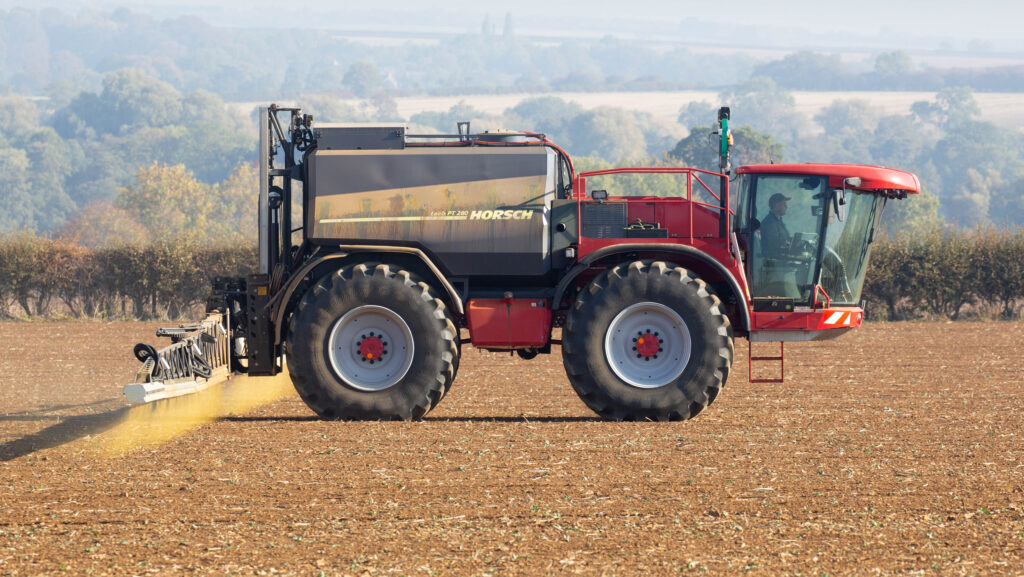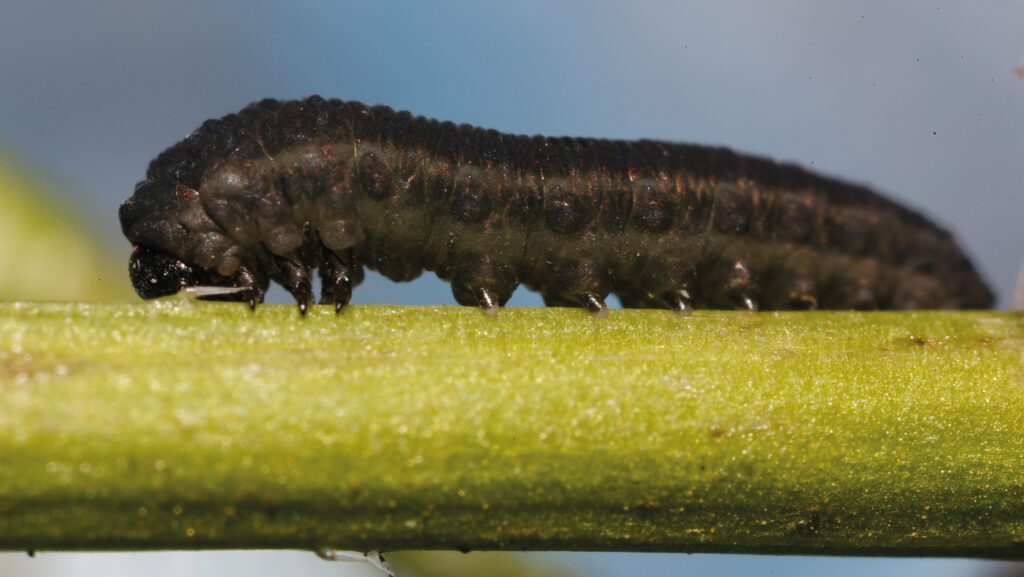Crop Watch: Slow wheat drilling progress and high slug pressure
 © Tim Scrivener
© Tim Scrivener As we enter the main wheat drilling season, progress is slow, with very variable field conditions.
In the North, the late havest has resulted in drilling being delayed by 2-3 weeks.
Oilseed rape crops have established well, but are under increasing slug pressure and grassweed flushes are being tackled as the clethodim herbicide cut-off date approaches.
West
Jamie Armstrong
AICC/Wessex Agronomy (Wiltshire, Gloucestershire and Hampshire)
As October arrives, farmers across the South West are entering the main window for drilling winter cereals. With varying field conditions being the main challenge, some farms are progressing well, while others have been hampered by heavy rainfall.
Most oilseed rape crops have established well, but slug pressure continues to cause problems in some later-drilled crops.
Flea beetle activity spiked during the warm spell in mid-September, but thankfully subsequent rainfall has alleviated the pressure, allowing crops to outgrow the pests.
Herbicide applications for volunteer cereals, grassweeds, and broad-leaved weeds are ongoing. However, the order of application can be challenging due to the necessary intervals between treatments.
With wet conditions persisting, there is a rising risk of phoma and light leaf spot in forward crops. Frequent inspections will be key to early disease identification and timely fungicide applications when thresholds are met.
Winter cereals
Drilling of winter wheat and barley is underway, but progress has been slow due to the exceptionally wet end to September.
Lighter, free-draining soils are experiencing better conditions for fieldwork, but waterlogged soils may still be causing delays on farms with heavier land.
It’s proving difficult to strike a balance between: “don’t panic; it’s early October” and: “if it’s got to be muddled in, then better sooner rather than later”. As is so often the case, hindsight will hold the answer.
The current wet conditions are creating an ideal environment for slugs, particularly in oilseed rape and recently drilled cereals.
Seed-beds that are not rolled post-drilling due to tricky conditions will face increased slug pressure.
To manage this risk, ferric phosphate pellets are being recommended as a preventative measure, but regular monitoring still remains vital after application.
The maize harvest is in full swing, and damage from the European corn borer is becoming evident in some crops. Managing this pest in future seasons requires a proactive approach.
Growers can significantly reduce larval populations by topping and ploughing stubbles after harvest.
Of course, ploughing at this time of year isn’t the best practice due to soil erosion and run-off; leaving shattered stubbles exposed to the weather and birds can also help minimize pest numbers. Rolling stubbles post-harvest can further aid in control.
This autumn presents its fair share of challenges, but adaptability and patience will help navigate the season. Let’s hope for a dry spell ahead to ease the workload.
South
Alice Whitehead
Zantra (Essex/Kent)
After a lovely dry harvest where almost no crop drying was needed, we find ourselves again in the situation we were in for the majority of last season – too wet.
Most OSR crops were drilled in September due to August being extremely dry, and so far, look well where they have been protected from slugs, which have been relentless in some areas. I am slightly worried about the vulnerability of crops going into the winter with little biomass – they won’t withstand much pigeon pressure.
On the plus side, there has been virtually no adult cabbage stem flea beetle (CSFB) seen at all in this area. I have been using the new Magic Trap from Bayer which remotely monitors flea beetle adults via a mobile phone app – it has correctly identified the few CSFB adults caught in the water, which is impressive.
OSR weeds
The recent deluge has created a nice flush of grassweeds so Centurion Max (clethodim) has been applied if the crop growth stage is still up to six true leaves.
I always use a water conditioner (added to the tank first) to improve performance of the herbicide.
Belkar is being used where cleavers and crane’s-bill are a problem, or Cleravo (imazamox + quinmerac) where I have difficult brassica weeds in Clearfield crops.
I am finding turnip sawfly in a variety of brassica crops – not just oilseed rape. A pyrethroid added to the herbicide will control these, as they can create a bit of a mess if left unchecked.
Cereal drilling is yet to get off to a decent start, with only the odd field drilled as I write this.
Those that have been drilled have not been rolled and have mostly missed the pre-emergence herbicide.
There is a general feeling of doom and gloom as time ticks on into October and no decent areas are drilled up, especially after the difficult season we have just experienced.
Hopefully, we will have a few decent weeks and things will look very different by the time I write my next report.
At least we have had a good flush of ryegrass and blackgrass, which should put us on the front foot in trying to control these weeds in cereal crops.
Residual herbicide choices will remain flexible according to growth stage, conditions and rainfall to try and limit crop phytotoxicity.
East
Becky Finbow
Agrovista (Norfolk/Suffolk)
There is a slight feeling of deja vu here in the East as this article is being written with the rain pouring outside my window – some farmers in Norfolk have recorded over 60mm in just a week.
Many have been divided this autumn, some have decided to drill early and are sitting smug with their seed in the ground, while others have held out and waited for a blackgrass flush which has finally started to appear.
Most that have drilled early have also managed to spray a pre-emergence, although with some areas having unexpected amounts of rain, we will have to sit patiently and wait for any crop effect.
With the new BASF co-form on the market this autumn, farmers are having to make decisions whether to put it on pre-emergence or use other chemistry and hope they can return post-emergence with the co-form for bad grassweeds.
Aclonifen still has a place in my programmes, being slightly cheaper and still doing a good job.
Whether you are using one or the other or both, tri-allate is a definite partner.
It has been used for years, long before I have been an agronomist, but has really come into its own the past couple of years being applied in either liquid or granular form alongside pre-emergence. This moisture will definitely help kick it into gear.

© Blackthorn Arable
Oilseed rape
Oilseed rape crops of whatever size seem to be growing nicely this year, with very little flea beetle damage being seen. In fact, slugs and turnip sawfly damage has been more noticeable.
Small crops are still being walked for grassweed control, either Falcon (propaquizafop) or Centurion Max (clethodim) depending on the grassweed, or for broad-leaved weeds Belkar (halauxifen + picloram).
Please note clethodim applications must be on before the six-leaf stage and before 15 October.
Large, early drilled OSR crops may require growth regulation.
Caryx (mepiquat + metconazole) would be my go-to, although I would consider the use carefully, as our feathery friends the pigeons will no doubt be wanting some food sooner or later, our natural plant growth regulator.
Fingers crossed the weather begins to play ball and we can start our drills rolling again and have a more successful autumn.
North
Conor Campbell
Hutchinsons (Northumberland)
Harvest is all but finished here in Northumberland, with spring pulses and maize left to go.
The beans seem to be taking an incredibly long time to die and are starting to make a few of us wonder if we forgot the spray them off. The days of diquat were good ones.
Crop moisture was an issue all harvest, with damp days holding the grain moistures up and many being forced to cut crops wetter than they would have liked to be able to make progress.
Drilling is well underway, unlike this time last year, with barleys and first wheats in the ground and beginning to emerge.
Slugs haven’t been an issue, but recent wet weather is starting to favour them, so attention will be needed in this department.
Suffering soils
Soils have suffered a lot over the past 12 months, with many of them having been worked and sown twice, meaning the heavier ground has been a struggle to work down for some.
So far we have thankfully missed a lot of the heavy rain, and I feel for those further south when I hear the rainfall figures being quoted.
The one crop of the month has to be oilseed rape. This is the first time that my acreage has decreased, with customers dropping OSR in favour of oats or Sustainable Farming Incentive options.
The usual stressful period of checking crops two to three times a week, battling slugs and CSFB has actually been relatively straightforward.
The early sown crops after winter barley are wall-to-wall at six true leaves, with the later-sown fields starting to play catch-up.
Some hefty plant growth regulator would be a good idea to strengthen the growing point and regulate the bigger crops – this is a nice problem to have.
I will be waiting for some colder weather before applying propyzamide, so we can hit the target weeds and soil.
For many, drilling is 2-3 weeks behind our traditional schedule with the knock-on effect of late spring sown cereals delaying harvest, so there is more to be sown in October than might usually be the case.
However, when I think back to last autumn while driving around the county and looking at fields starting to green up, I can’t help but feel an air of positivity.
I’ll keep my fingers crossed for a good season ahead as I think we all deserve one!

